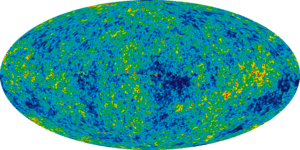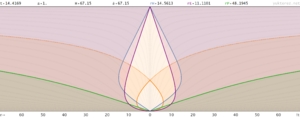Big Rip facts for kids
| Physical cosmology | ||||||||||||||
 |
||||||||||||||
| Universe · Big Bang Age of the universe Timeline of the Big Bang Ultimate fate of the universe
|
||||||||||||||
The Big Rip is a scientific idea about one possible way the universe could end. It suggests that everything in the universe, from huge galaxies to tiny atoms, could be pulled apart by a mysterious force called dark energy. This would happen because the space between everything would stretch faster and faster until nothing could hold together anymore.
Scientists believe our universe is expanding, and this expansion is even speeding up. This is because of dark energy. In the Big Rip idea, this dark energy would get stronger and stronger over time. If this happens, the universe would expand so quickly that it would eventually tear apart everything, even the smallest particles.
The Big Rip is only possible if a special kind of dark energy exists, called "phantom energy." This phantom energy would have very unusual properties that make its density increase as the universe expands.

| Type | Cosmological model |
|---|---|
| Proposed by | Robert R. Caldwell |
| Related to | Dark energy, phantom energy |
Contents
What is the Big Rip?
The idea of the Big Rip depends on the type of dark energy in our universe. If dark energy keeps getting stronger, it could eventually overpower all other forces. These forces normally hold everything together, like gravity holding galaxies or planets.
Scientists use a special number called w (the "equation of state parameter") to describe dark energy. This number tells us about the pressure and energy density of dark energy.
- If w is between -1 and 0, the universe expands faster, but dark energy gets weaker over time. So, no Big Rip.
- If w is less than -1, it means the dark energy gets stronger as the universe expands. This is the "phantom energy" that could cause the Big Rip.
How the Rip Happens
If phantom energy is real, the universe would expand faster and faster. This means that the part of the universe we can see would shrink. Also, the distance over which forces can act would get shorter.
Eventually, the universe would expand so quickly that even the strongest forces couldn't hold things together.
- First, galaxies would be pulled apart.
- Then, stars and planets would be ripped away from each other.
- Finally, even atoms themselves would be torn apart.
At the very end, all distances would become infinite. This final moment is called the "Big Rip."
When Could the Big Rip Happen?
Scientists have a formula to estimate when the Big Rip might occur. It depends on the value of w and other things about the universe.
Observations from telescopes like the Chandra X-ray Observatory have tried to measure w. These measurements suggest that w is very close to -1. More recent data from the Planck mission, a space telescope, suggests w is around -1.028.
If w is indeed less than -1, even by a tiny bit, the Big Rip could happen. Based on current data, the earliest it could happen is about 200 billion years from now. That's a very, very long time!
A Possible Example
To help understand the Big Rip, scientists have imagined a scenario where w is -1.5. In this example, the Big Rip would happen about 22 billion years from now.
Here's how it might unfold in that example:
- 200 million years before the Rip: Galaxies would start to drift away from each other.
- 60 million years before the Rip: Galaxies would begin to break apart because gravity wouldn't be strong enough to hold them.
- Three months before the Rip: Our Solar System would fall apart. Planets would fly off into the rapidly expanding space.
- Last minutes before the Rip: Stars and planets would be torn into pieces.
- 10-19 seconds before the Rip: Even atoms would be destroyed. First, electrons would be pulled away from their atoms. Then, the centers of atoms (nuclei) would break apart.
At the exact moment of the Big Rip, everything would be infinitely far apart.
What We Know Now
Current evidence shows that the value of w in our universe is very, very close to -1.
- If w were exactly -1, the Big Rip would never happen. The universe would keep expanding, but it wouldn't tear itself apart.
- Because of how we measure things, it's almost impossible to say if w is *exactly* -1 or just incredibly close to it.
This means that while the Big Rip is a fascinating idea, scientists are still working to find out if it's truly a possible future for our universe. More accurate measurements in the future will help us understand this better.
See also
 In Spanish: Teoría del Big Rip para niños
In Spanish: Teoría del Big Rip para niños
- Big Bounce
- Big Crunch
- Heat death of the universe
- Last Contact – A short story about the Big Rip

